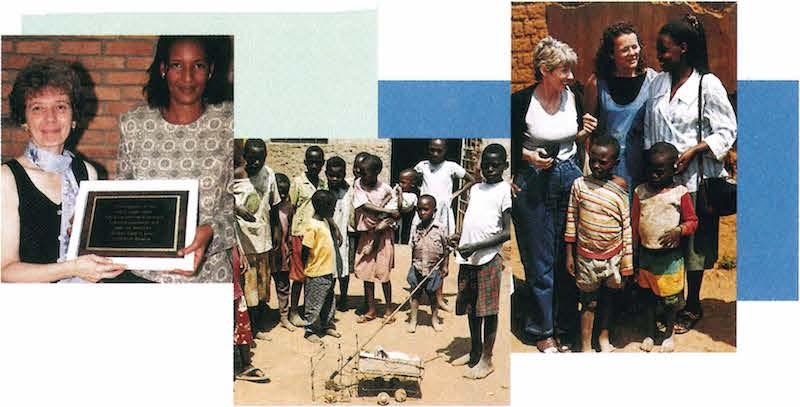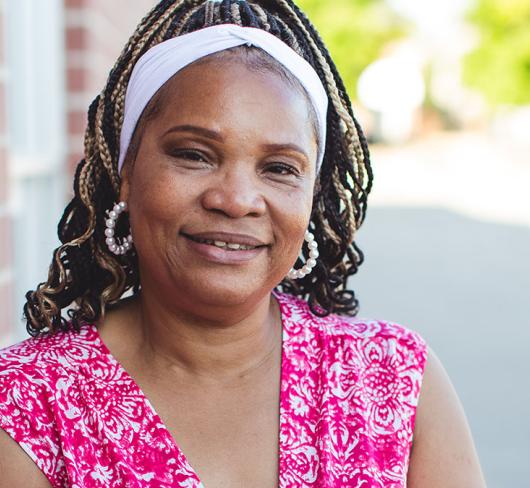
War-Affected Children
As I write this article, I am watching the leaves fall and thinking about the coming hockey season and the snow that is sure to fall in the next few days. I remember as a child growing up in the east end of Montreal how this time of year was always a time of excitement, of eager anticipation to get on the ice. If I try very hard, I can sometimes even remember the shouts and laughter of the first games of the season on the outdoor rinks that used to be our winter playgrounds. It was only relatively late in life that I discovered how fortunate I had been to have that sort of childhood.
Over the past few years, I have written and spoken a great deal about what I saw in Rwanda. Some of the images will probably haunt my dreams for the rest of my life. One of them is of a seemingly endless file of refugees laden down with everything they could carry hurrying away from Kigali. They look over their shoulders at me and their eyes seem completely masked by fear. They are silent but I can feel the unspoken plea for help. Among them are thousands of children. Over the sound of shuffling feet, I hear the muted whimpering of hungry and frightened children. In my dream, I hear their hushed voices slowly fading into silence.
When we speak of the effects of war on children, we most often think of bombs and gunfire. But that is only a small part of what children suffer when war rips apart their world. While many thousands may be butchered or maimed, many more hundreds of thousands will follow their parents in terror-stricken flight away from the source of immediate danger. In the initial panic, few can grasp what sort of misery lies ahead. Even if they did, they would have no choice. They either run or perish. But as the children flee, they leave childhood behind and enter into a world of adult brutality.
The first stop on the road to safety is usually a spot along the road that offers the illusion of safety from the sheer accident of many people succumbing to exhaustion in the same place. There may be no water, no food, no shelter. Only those who have been able to carry food and water will eat. Only those with blankets will find warmth at night. For those who remember the graphic images of Goma in 1994, it is easy to picture the kinds of extreme conditions refugee children face. Only the strong and the lucky make it to a refuge. Those who survive the first flight most often find themselves in a camp where conditions are, at best, medieval.
To picture a scene from a typical African displacement camp, imagine a mud-brick room filled to over-flowing with children sitting on the floor trying to learn to write using only slate tablets and a piece of chalk shared among two or three of them. Imagine those same children at recess chasing a ball made from wrapped banana skins across a dusty, sun scorched clearing in the midst of a camp. These children will almost invariably be constantly hungry; most will eat only one meal per day. Many will have swollen bellies from worms or other parasites, the consequence of bad water and poor hygiene.
If you wander close to the edge of the playground, you may come close to the latrine. Breathe through your mouth and thank God you don’t have to go in. On the sidelines there will probably be a few children on home-made crutches looking on wishing they had not lost a foot or a leg to a mine. At nightime, these children will go back to share a miserable hovel made of mud and roofed with grass or, if they are lucky, covered in tattered plastic sheeting provided by one of the aid agencies. They will probably sleep among brothers and sisters who hack and cough through most of the night, trying to cope with lung infections without medicine. In the morning they wake cold and hungry and go through the same thing again. Chances are, these are the lucky ones, the ones who at least have food and access to rudimentary education.
War in our time has changed. It is no longer an affair between armies in which both sides try to avoid hurting civilians. In so much of Africa and in so many of the developing nations in other parts of the world, politics spills over into a form of violence that seems deliberately aimed at civilians.
In some places, such as in northern Uganda, there are armed groups that target children. There, the Lord’s Resistance Army has developed the tactic of attacking villages, rounding up all the children and then forcing them to carry the loot they gather. Those that falter are killed, often by the other children. The commanders force the children to kill their friends as a means of pushing them across a psychological hurdle. Once they have blood on their hands, they feel guilty and unable to go home.
In other conflict areas, like Sierra Leone, the Revolutionary United Front takes this one step further by deliberately addicting child captives to drugs and then sending them back into their own villages to commit atrocities while drugged. These children are brutalized to a degree difficult to imagine from the shelter of Canada. So are the communities they attack. Those who survive need special care if they are to have any hope of regaining a normal life. This usually entails a range of intervention, including therapy, that is simply not available in the society they live in. Yet if they are not helped they may, in despair, lash out again. Often, those who can’t find their way back to normalcy become tools in the hands of cynical leaders who use them to attack other children.
In other parts of the world, such as Pakistan, refugee children have, for nearly 20 years, lived in conditions of nearly complete neglect. In the Afghani case, many children without access to schools turned to the religious schools operated by sincere but poorly educated teachers of the Taliban. Whatever we may think of the Taliban, they filled a void left by donor neglect. At the time, we in the West were not paying enough attention. Now we have no choice.
The scale of the problem seems overwhelming sometimes. There are millions of children affected by war today. Solving their problems permanently means stopping wars. While we seem to be getting better at resolving some types of conflict, the United Nations, which was specifically designed to save us all from ‘the scourge of war,’ is a political organization and is therefore subject to a full array of political frailties. Suffice it to say that we are a long way from ending war. So what can we do?
We can find ways to help children at many different levels. In some cases, lobbying our own government to pay attention to the way children are treated in other countries with which we have diplomatic relations can make a difference. This seems now to be working to bring crimes against children under the jurisdiction of international war crimes tribunals and may eventually help set up a deterrent to gross child abuse.
At another level, the Canadian International Development Agency (cida) can, and does, fund specific programs with international non-governmental organizations. These organizations, including World Vision, Save the Children, and United Nations Agencies, such as the United Nations International Children’s Emergency Fund (UNICEF) and the United Nations High Commission for Refugees (unhcr), care for former child soldiers and provide humanitarian assistance to displaced children.
hese are often relatively small but important programs that make a tremendous difference in the lives of individual children. One need only see the hope in the eyes of one child going through the rehabilitation process run by World Vision in Uganda to see that there is no need for the kind of despair that leads to giving up. We can always find a way to help. There are other steps that can be taken as well to ease the burden of children who have no hope for the future. For so many of these children, just establishing contact with the wider world outside of the miserable camp they are stuck in may be enough to carry them through to better times. But there is one common element required in every intervention — caring enough to act.
Those of you familiar with the genocide in Rwanda will remember how little anyone did to stop the killing. I remember so many days in the midst of all that madness that began with the hope that someone, finally, would hear our calls for help and would do something. No one did. No one came. Yet today there are so many millions of children suffering from the same sort of indifference. They cry out for our help. We ignore them. We look away on purpose or we distract ourselves with other noise. When all of the speeches are finished and all of the reasons for not acting to help children have been stated, one simple fact remains: if we truly want to live in a better world, it is up to us to bring it into being. Where better to start than with children?
Lieutenant-General Romeo Dallaire first enrolled in the Canadian army in 1964. In 1993-1994, he led the United Nations Observer Mission - Uganda and Rwanda and the United Nations Assistance Mission for Rwanda, for which he was awarded the Meritorious Service Cross. He is currently the Advisor to the Minister of the Canadian International Development Agency on matters relating to war-affected children around the world.
Phil Lancaster acted as Lieutenant-General Dallaire's military assistant during the latter part of the Rwandan genocide. Since retiring from the army, he has been working with Unicef in Sudan, Uganda, Rwanda and Burundi.
Care enough to act. Support children who are victims of war. Contact the aid agency of your choice. Some suggestions are:
- Care Canada: www.care.ca
- Hope for Rwanda's Children: www.hopefund.on.ca
- Save the Children Canada: www.savethechildren.ca
- unicef: www.unicef.ca
- unhcr: www.unhcr.ch
- World Vision Canada: www.worldvision.ca
All these sites offer information on the plight of children, as well as numerous ways to help. Keep informed. Give as much as you can.
Hope for Rewanda's Children
In 1995, two ETFO members, Shyrna Gilbert and Leo Kabilisa, who met through their involvement in CTF’s Project Overseas and had been personally affected by the genocide, felt they had to do something to help. In conjunction with a group of concerned Rwandans and Canadians, they spearheaded an organization which became the Hope for Rwanda’s Children Fund. The Fund focuses its efforts on some of the estimated 500,000 children who were orphaned by the genocide.
The organization now has over 20 members, both from Rwanda and elsewhere, who work tirelessly to fundraise for the orphans. The funds go to help students stay in school and complete their education. Focusing on “hope,” fund members work with the Tumurere Foundation, a local non-governmental agency in Kigali, to assist over 100 children with school fees and educational supplies. Tumerere also provides social work assistance to help children-led households stay intact.
ETFO, through its Overseas Scholarship Fund, is currently helping Aurea Mujawimana, a social worker for the foundation, to pursue a four-year social work program at the Université Libre de Kigali. ETFO’s assistance is helping her study for the qualifications she needs to work effectively and to provide leadership for the foundation in the future.
In Ontario, some schools have adopted Hope for Rwanda’s Children Fund as the focus of school fundraising campaigns. Join Hope’s fundraising walk in High Park on May 5 at 1:00 pm. Entertainment follows at 3:00 pm. For more information, visit www.hopefund.on.ca
